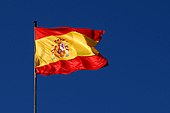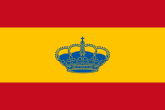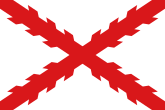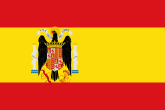Flag of Spain
| Flag of Spain | |
|---|---|
 |
|
| Vexillological symbol : |
|
| Aspect ratio: | 2: 3 |
| Officially accepted: | 19th December 1981 |
The flag of Spain , also known as “ Spanish la Rojigualda ” (meaning: “the red and gold”), was introduced on December 19, 1981.
description
The national flag consists of three horizontal stripes in the colors red-yellow-red, whereby the middle yellow stripe is twice as wide as the two red ones. The Spanish coat of arms is completely in the yellow stripe.
| Colours |
Pantone (approximate) |
HTML code |
|---|---|---|
| Flag red (Rojo Bandera) | 7628 C |
#AA151B
|
| Flag yellow (Amarillo-gualda Bandera) | 7406 C |
#F1BF00
|
On the back, the coat of arms is shown in the correct representation mirror-inverted, so it seems as if the coat of arms is shining through from the front. The banner is not mirrored so that it can be read from both sides.
variants
The flag without the coat of arms serves as a simplified variant of the civil and commercial flag . It was introduced on August 29, 1936. But their origins are even older.
While the Guardia Civil del Mar flies the flag with the coat of arms on their boats, the Customs Authority ( Servicio de Vigilancia Aduanera ) uses a Spanish flag with two crowned "H" on their boats, which stand for the Ministerio de Hacienda . Before 1977, the Spanish coat of arms with an eagle was on it.
Private yachts fly a Spanish flag with a blue crown in the center. There are different variants of it.

 ? Civil and commercial flags, variant without coat of arms
? Civil and commercial flags, variant without coat of arms
More flags
Gösch the Spanish Navy (Torrotito)
Standard of the Prince of Asturias
Spanish flag with Osborne bull
A popular, unofficial flag used primarily by sports fans is the Spanish flag with the silhouette of the Osborne bull .
history
The first flags of the kingdoms on the Iberian Peninsula were heraldic banners ; Flags depicting the coats of arms of the kings. With the unification of the empires, the coats of arms were also merged into a single one. The royal banner from 1492 shows the coats of arms of Castile , León , Aragon and Granada .
From 1506 to 1785 the Spanish war flag showed the cross of Burgundy with reference to the origin of the ruling dynasty . It refers to the House of Habsburg , as the first Habsburg to rule in Spain, Philip the Handsome , inherited the title of Duke of Burgundy from his mother Mary of Burgundy , and was used in the Bourbon period. It was also the predominant flag in the Spanish colonies when they were under the direct rule of the mother country. However, this flag was not a national flag as it is today, because the concept of nation did not exist at the time. The task of representing the state was still carried by the royal coat of arms , which was shown in the form of a flag on a red or white background.
In order to better recognize the ships of the Armada in sea battles , Charles III decided . to introduce a new naval and military flag. From several drafts submitted to him, he selected a yellow flag with two horizontal red stripes at the top and bottom (proportions 1: 2: 1) and declared it the new flag on May 28, 1785. This flag was the direct ancestor of the modern Spanish flag. As a royal standard it carried the coat of arms of Castile and León (castle and lion). The merchant navy used a similar flag from this time on, but the red stripes did not start at the edge of the flag, but were separated from it by yellow stripes. The color sequence was yellow-red-yellow-red-yellow with proportions 1: 1: 2: 1: 1, this was used until 1927.
 ? The Cross of Burgundy - Spain's war flag from 1506 to 1785
? The Cross of Burgundy - Spain's war flag from 1506 to 1785
 ? Flag of the Kingdom of Spain from 1785 to 1873 and from 1875 to 1931
? Flag of the Kingdom of Spain from 1785 to 1873 and from 1875 to 1931

 ? Commercial flag of the Kingdom of Spain from 1785 to 1927
? Commercial flag of the Kingdom of Spain from 1785 to 1927
The flag of the short-lived First Spanish Republic corresponded to that of Charles III. introduced flag except for the removal of the royal crown from the coat of arms. In newer versions of the flag, the coat of arms is a shield divided into four parts with the symbols of the former kingdoms of Castile, León, Aragon and Navarre (see coat of arms of Spain ).
The flag of the Second Spanish Republic shows three equally wide stripes in red, yellow and purple with the coat of arms (crowned by a wall crown ). The purple stripe is reminiscent of the Comuneros uprising in Castile (1520–1522) against the rule of King Charles I. This flag is the only national flag that contained a purple stripe.
Under the Franco regime (1936–1975), the old color scheme red-yellow-red was returned in 1938. During the civil war , the use of the older flag, which differed from the colors of the republic, was established within the associations of the nationalists . In 1945, a new flag law was finally passed, which regulated the details of the coat of arms on the red-yellow-red flag. The national coat of arms was held here by an eagle. To his right and left you saw the yoke and bundle of arrows and the stylized columns of Hercules , which had appeared in the unofficial army flags as early as 1940. The slogan was "VNA GRANDE LIBRE" (Einig Groß Frei). The flag was modified after Franco's death in 1977 and abolished with the transition of Spain to the constitutional monarchy in 1981.
The aspect ratio of the red-yellow-red striped flags always remained unchanged at 2: 3.
 ? Flag of the Spanish Nationalists under General Franco, 1936-1938
? Flag of the Spanish Nationalists under General Franco, 1936-1938
 ? Flag of Spain under General Franco in the variant from 1938 to 1945
? Flag of Spain under General Franco in the variant from 1938 to 1945
 ? Flag of Spain under General Franco in the variant after 1945
? Flag of Spain under General Franco in the variant after 1945
Subnational flags
In addition to the autonomous regions of Spain, the autonomous cities of Ceuta and Melilla also have their own flags, as do the subordinate administrative units and the individual islands of the Balearic and Canary Islands.
literature
- Smith / Neubecker: coats of arms and flags of all nations. Munich 1981, ISBN 3-87045-183-1
Web links
- Flags of the World - Spain (English)
Individual evidence



















